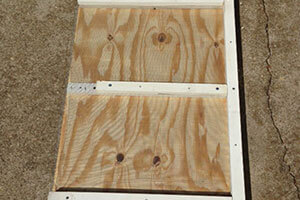
I have had some inquiries about the equipment for a two-queen hive in the horizontal position. I am using a single deep hive body for each queen. Some people have asked about using the medium “Illinois” size equipment. One of the medium depth hive boxes is not enough space to overwinter a colony. It is difficult enough to slow down the swarming from a colony that resides in a single deep. A standard deep hive body, Langstroth measured, will contain a single colony. Anything smaller is too small. Using more than one hive body, such as two mediums, defeats the purpose of a horizontal arrangement for a two-queen system.
Research has indicated why larger colonies produce so much more honey than small colonies. In a large colony the number of foraging bees can reach nearly 10%. That is 4,000 – 5,000 foraging bees in a strong colony during the honey flow. In a small colony the number of foragers is less than 5%. That is only 1,000 foragers for a colony of 20,000 bees. It is unlikely that a colony with 20,000 bees can produce any surplus. With a two-queen system, 10,000 foraging bees are possible. In theory, that many foragers could produce 3 – 4 times the honey of a single colony with 50,000 resident bees.
In a larger colony, bees tend to start foraging earlier in life. The horizontal system does not permit bees from both colonies to nurse one another’s brood. Foraging behavior may start sooner. There have been reports of reduced swarming within the two-queen vertical colony. It is suggested that two queens providing more queen pheromones would have the effect of swarm reduction. There would be less worker exchange between the two colonies in a horizontal system. I hope that swarm reduction does work within the two-queen horizontal colony. One thing is certain; the two queens must be kept apart.
Queens in a two-queen horizontal hive must not be allowed to meet since they will fight to the death. Queen pheromones, especially mandibular pheromones, let the workers know a queen is in the colony and actively laying eggs. Queens also have scent marks left behind by their feet when the queens walk across the combs. When queen pheromone becomes weak, workers will build queen cells. The swarm cells are usually built at the bottom of frames farther away from the queen. With more than one queen, more queen pheromone should be available to bees in both side by side colonies. Therefore, swarming may be reduced. We must remember that having space within the brood nest of a colony is a big factor as well.
Any strong colony can be a source of bees. Removing a frame or two of capped brood and replacing them with frames of foundation placed to the side of the brood nest is known to reduce swarming. We have talked about keeping the two sides of a dual queen system close to equal strength by donation of brood from one side to the other. It is expected that more brood would be produced within the two-queen colony than within a single colony. Therefore, a dual queen system could, in theory, produce capped brood for weak colonies in any apiary.
It is unlikely that any single colony or one side of a horizontal dual queen colony would be able to have more than 2 frames of capped brood removed in a season and maintain productivity. The old adage is a colony can produce bees, as in nucleus colonies, or honey, but not both. Keeping that maxim in mind, never take more than one frame of brood at any one time from a honey-producing colony. That brood should only be removed from strong colonies in danger of swarming. It is possible that a second frame of brood could be taken two or three weeks later and not reduce production. Capped brood removal from only the strongest colonies is the best policy.
There is some speculation on the best race of bees to use. There are new mechanisms of Varroa resistance becoming available for sale in new queen genetics. Some bees are more …


